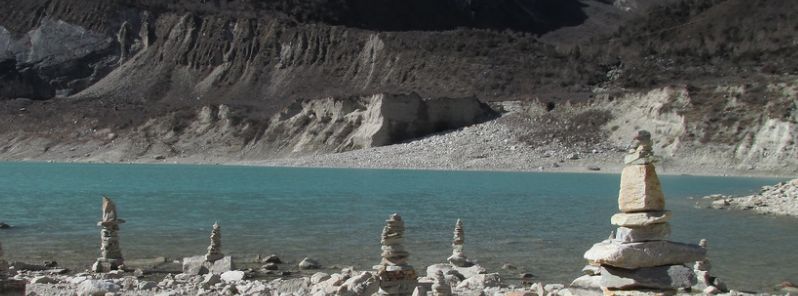Risky glacial lake near Mount Everest drained

Because Himalayan glaciers are undergoing an incredibly fast melting process, to minimize the risk of devastating floods, Nepal has drained portion of a large glacial lake near the Mount Everest.
According to researchers, the climate change has caused the glaciers in the region of Himalaya mountains to melt at an alarming rate. The melting process could create large glacial lakes that could easily break their banks and endanger the local villages. After the M7.8 earthquake that rattled the region last year, the risk of flash floods in the region has further increased.
Thus, the government of Nepal, in cooperation with the United Nations Development Programme (UNDP) decided to drain Imja Tsho, the fastest-growing lake of glacial origin in Nepal, situated at the altitude of about 5 km (16 437 feet) and almost 150 m (492 feet) deep.

Video credit: NewzstreetTV
The huge area, ranging between 0.4 and 1.01 square kilometers (0.15 and 0.39 square miles) in size during the period between 1984 and 2009, caused the experts to become worried about it breaching its banks and flood the local villages. Such an event would cause a disaster that could potentially impact over 50 000 people, both locally and in southern parts of the country.
According to Top Bahadur Khatri, the project manager of the Community Based Flood and Glacial Lake Outburst Risk Reduction Project, so far the workers drained over 5 million cubic meters of water (176 million cubic feet) and managed to lower the water level by 3.5 m (11.5 feet), as they
"Draining the lake was on the priority of the government because of its high risk. We have successfully mitigated a disaster right now," said Khatri.
"A 45-metres long tunnel was constructed to aid outflow of the lake downstream. We have also installed a mechanical gate to control the discharge," said Lieutenant Colonel Bharat Lal Shrestha, a leader of the Nepal army personnel that participated in lake draining along with over 100 other workers.
Khatri explained the plan is to replicate the work in other high-risk glacial lakes, and as a part of it, the early warning systems have been put in place across the local downstream villages.


Video credit: Amrit Banstola
The Glacial Lake Outburst Floods (GLOFs) are not unknown in Nepal, as they have been happening for several decades. A first such outburst, of the Dig Cho lake, was reported in 1985, and it raised awareness of the phenomenon and importance of studying it. The Water and Energy Commission Secretariat (WECS) in Nepal have announced five potentially dangerous lakes in 1996, all above 4 100 m (13 451 feet) in altitude, including Dig Tsho, Imja, Lower Barun, Tsho Rolpa, and Thulagi.
A study conducted in 2001 by UNEP and ICIMOD have named 20 potentially dangerous lakes, of which ten have already flooded during the last few years.
Some dangerous lakes also exist in parts of Tibet and are drained by streams that cross into Nepal. If outburst incidents happen in Tibet they can also cause downstream damage in Nepal.
The concern of flooding related to glacial melting significantly rose in 2014 after an international study revealed the region of Mount Everest could shrink by 70% or even disappear entirely due to climate change. Nepal hosts about 3 000 glacial lakes, and it is easy to understand the concern about flooding risk.
Featured image: Glacial lake above Sama, Nepal, November 13, 2013. Image credit: Rick McCharles (Flickr-CC)

Commenting rules and guidelines
We value the thoughts and opinions of our readers and welcome healthy discussions on our website. In order to maintain a respectful and positive community, we ask that all commenters follow these rules:
We reserve the right to remove any comments that violate these rules. By commenting on our website, you agree to abide by these guidelines. Thank you for helping to create a positive and welcoming environment for all.